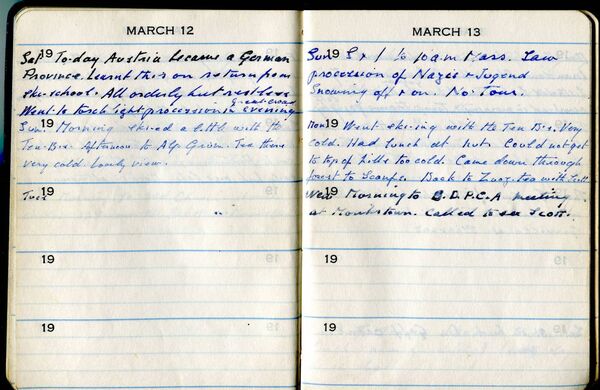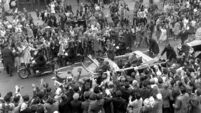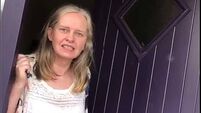Clodagh Finn: We are made of stories. It’s time to tell yours

Letitia and Naomi Overend with Letitia's Rolls Royce. Picture: Courtesy of the Airfield, Dundrum and the OPW-Maynooth University Archive and Research Centre
It might not be the time to extol the virtues of a fuel-inefficient luxury car, but Letitia Overend, philanthropist, farmer, and amateur mechanic, couldn’t say enough for the Rolls Royce she bought in 1927 for £1,700. It never gave her a day’s bother in 50 years, she said.
Her sister Naomi drove a 1936 Austin Tickford and was an equally keen motoring enthusiast. Their respective cars gave them both a freedom unusual in the 1930s and ’40s and they used it to travel to vintage car rallies, visit family, and explore the country from their base at Airfield Estate in the centre of Dublin.
Letitia famously serviced her own car too, a skill she learned at the Rolls Royce school in London. She couldn’t stay to complete the course so she didn’t like to describe herself as a mechanic; she was “just a good house maid”, she said in 1973.
Throughout their eventful lives, these two women challenged stereotypes in so many different ways. You’ll get a sense of them if you visit Airfield in Dundrum, the estate they left in trust to Ireland and “Dublin’s only urban working farm and gardens”.
I got to know them a bit better in Maynooth when Nicola Kelly, archivist at the OPW-Maynooth University Archive and Research Centre, showed me samples from their many papers, personal letters, and photographs.
HISTORY HUB
If you are interested in this article then no doubt you will enjoy exploring the various history collections and content in our history hub. Check it out HERE and happy reading
The photos that jumped out at me were the ones Naomi took when she happened to get caught up in the German annexation of Austria.
In March 1938 Naomi Overend watched as German troops poured into the Austrian skiing village of Kitzbühel, vaguely aware that she was witnessing the annexation of Austria into Nazi Germany in what became known as the Anschluss.
She took several pictures and wrote home to tell her mother and sister not to fret; she had been assured there was no risk of any disturbances even though there were soldiers everywhere and the streets were full of leaflets and Nazi flags. When it became clearer what was happening, she said it was amazing to see people quietly going about their business when the country had just “changed hands”.
“Don’t be uneasy,” she wrote to “dear Mogs” [her mother’s nickname]. “It is quite alright and everything just as usual. They even held a slalom race this morning [in] the middle of it all! So if we are not wanted back in a hurry we will stay on here while the snow lasts.
"Very fondly written on a [much] too high table.”
There were several other revealing vignettes in the Overend archive, fleshing out the lives of a family whose thoughts, memories and experiences are so carefully preserved. Among the most moving are the letters the women’s parents, Lily and Trevor, sent to their daughters as young children.
The couple sent sweet, illustrated letters from various holiday destinations. When Letitia was eight (in 1888), her mother’s letter included a sketch of Trevor battling a mosquito on a lake in Switzerland. When they reached Paris, she sent another of the couple at breakfast in the Grand Hôtel eating French bread which, she said, was “long like poles”.
The first letter Trevor wrote to Naomi (“My dearest Sweetest Peepsie”), when she was two (in 1902), gives an insight into how Airfield House was developing as a farm. He asked about “Bugley and Jersey and Suckey and Bon”, with each name drawn inside a picture of an animal.
I was reminded of that wonderful collection last week at the launch of the Explore Your Archive campaign by the Archives and Records Association, Ireland. While one group of people was rioting in Dublin, intent on tearing the city down, another group of people had gathered in the Irish Traditional Music Archive (ITMA) on the other side of the city to talk about preserving what we hold dear.
If you are not familiar with the ITMA, it’s on Merrion Square in Dublin and, as digital archivist Dr Adam Girard reminded us, it’s not only open to everyone, but you don’t even need an appointment to explore its collection of sound recordings, books, videos, images, and manuscripts.
Archivist and award-winning musician Niamh Ní Charra knows its facilities only too well because that is where she spent months researching material for her tribute album to fellow Sliabh Luachra musician Terry ‘Cuz’ Teahan who emigrated to Chicago in the 1920s, in his 20s.
“Shortly before he died,” she explains, “he visited Ireland for the last time and saw me playing as a very young girl for the tourists in Killarney. He was really taken with me and when he returned to Chicago he sat in his kitchen and recorded a tape of music for me, talking to me too.”
, the album, was released in 2013 to glowing reviews. Here’s a line from one of them written by Síobhan Long: “The riches to be mined from the music of Sliabh Luachra are inexhaustible, and Niamh Ní Charra’s beautifully rough-hewn collection celebrates its bounties with chutzpah.”
The album’s cover photograph is of a specially commissioned piece of embroidery designed by Máiread Delaney (also archivist at the Abbey Theatre), based on Cuz Teahan’s work. “Cuz was an avid embroiderer and relied on money earned from the selling of his pieces during the hard years following the depression in America,” the cover note explains. Several of his pieces are now in the folklore section of the Smithsonian Museum in Washington.
There’s more to the story because the experience prompted Niamh to become an archivist: “I realised the profession of archivist had much in common with that of professional Irish traditional musician — preserving tradition, checking provenance, and passing on knowledge.”
Now, in her role as communications and campaigns officer of the Archives and Records Association, Ireland (ARA, Ireland), she is encouraging everyone to explore the diverse collection of archives in Ireland.

As she says, archives have the “unique potential to educate and excite people, bring individuals and communities together, and unearth compelling stories”.
As garda cars, a bus, and the Luas were being set alight a little more than a kilometre away, the ARA’s chair Janet Hancock was making the point that archives contain stories and those stories have the power to bring us together.
Her words reminded me of a quote sent to me recently by a friend: “Scientists told me that human beings are made of atoms, but a little bird told me that they are also made of stories.”
That beautiful quote is from Uruguayan writer Eduardo Galeano, but it might have come from an archivist, those under-rated collectors of stories who safeguard the rich, varied, and nuanced records of our past and recent past. Get out and explore them.











